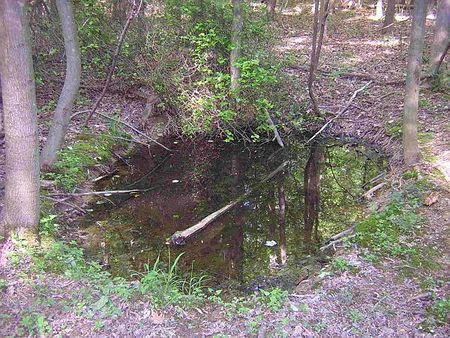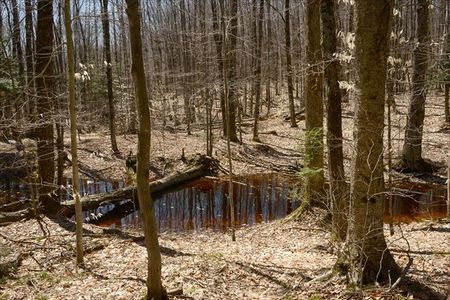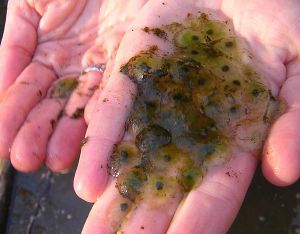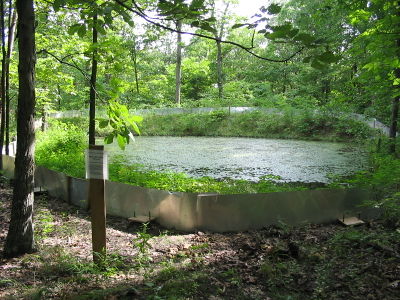Vernal Pools: Difference between revisions
No edit summary |
|||
| Line 48: | Line 48: | ||
[[File: ArtificialPool.jpg|400px|left|thumb| A vernal pool that was created by humans in an attempt to restore a wetland ecosystem. [6] ]] | [[File: ArtificialPool.jpg|400px|left|thumb| A vernal pool that was created by humans in an attempt to restore a wetland ecosystem. [6] ]] | ||
==References== | ==References== | ||
Revision as of 07:12, 11 May 2018
Overview

A vernal pool is a seasonal pool of water that is typically characterized by being relatively small, shallow, and ephemeral. A vernal pool is filled in the spring by rain and snow melt, and then dry up when summer starts to come around. These pools can last longer if the soil beneath them is made up of fine silt; Making the percolation rate slower. These pools can form not only near other wetlands, but in any low lying area with a soil structure that is capable of holding water for a short period of time. These pools of water are vital ecosystems for organisms like frogs, fairy shrimp, and other insects and amphibians. Vernal pools have been found on the tops of upland areas, woodlands, and urban areas. The key characteristic that contributes to the importance of these pools is that they are separated from other water bodies. When considering the characteristics of vernal pools, it is evident that vernal pools are unique and temporary wetland ecosystems. [1]
Formation of Vernal Pools
In order for vernal pools to form, many factors have to align. The Topography, water table (sometimes), and soil history all have to be just right before a vernal pool will typically form. Most vernal pools only occur in the Western Region and the Northeastern Region of the United States. They will form however in many parts of Canada, and many other Mediterranean or Subtropical regions on earth. [3]
The topography of a region is very important in an area that has vernal features. The area typically will be a flat lying area that displays divots in the ground along the flat area. The type of rock in the area will also assist in the formation of vernal pools. If there is igneous rock or bedrock underneath the soil, the formation of vernal pools will be promoted greatly. Even if the rock is suspended on a hill or a mountain, it creates a situation where the infiltration of water into the soil is limited because the rock is essentially impermeable shortly under the ground. [3]
Most believe that the water table in a region is the sole reason behind vernal pool formation, but this is not the case. Although the water table in an area can be extremely important in vernal pool formation. If the area has a higher water table, vernal pool formation will be promoted because water is more likely to pool up on the surface in the Spring months and create vernal pools; This is common in wetland areas and near stream beds. However, the water table does not have to be high in order for a vernal pool to form. Vernal pools can form due to the rock below and holding runoff in an area, creating a suspended water table or a lower infiltration rate in that area. [3]

The soil in an area is often the fundamental reason that vernal pools are able to form in an area. Mainly because of what geological feature existed there once before. Areas that promote vernal pool formation are areas effected by glacial action, floodplains, sag ponds, and even areas with human activity. Floodplains are common areas for vernal pools because when there is high water or even a flood, areas that have a water pocket will remain full of water for a short period of time. This is most common in the spring where there is high amounts of snow melt and rain, thus making vernal pools. Areas that have been effected by glacial action are very susceptible to vernal pools because of the way that the glaciers leave the ground. Glaciers create many depressions, scrapes, scours, and erosion in areas where they travel or melt away. The Northeastern region of the United States is the way it is mostly because of the glacial sheet that last retreated. These features that are left behind form glaciers are able to fill with precipitation and become a vernal pool. A sag pond is created when there is an underlying rock that is weathered relatively easily. When the rock under the soil weathers, a depression will form in the soil above to fill the void of non-existent rock. This then creates an area for the water to pool, and to stay because of the rock below the soil. Also, humans are responsible for creating vernal pools because of their importance to the ecosystem. Vernal pools are becoming more and more rare due to human activity, so humans are now creating small vernal pools that allow and promote amphibians and insects to have a habitat once again. Also, many human activities like mining and ditch digging have a side effect that is perfect for vernal pools to form.
Ecological Importance
Vernal pools are the best habitat for many insects, amphibians, and plants; Even though they are only around for sometimes weeks. The main advantage that vernal pools have over other bodies of water is that there are no other aquatic species in the water. There are no fish that will prey on the organisms creating a home in the pools. Additionally, many birds will use the vernal pool as a seasonal water source if it is large enough. Although much of the importance tied to vernal pools is due to the overwhelming amount of biodiversity in the systems, including rare invertebrates, crustaceans, insects, and plant species.
Some rare (and endangered) plant species that thrive in vernal pools are, Shumards Oak, Raven's-foot sedge, squarrose sedge, and false hop sedge. [4]
Some rare animal species that depend on vernal pools are, Tiger Salamander, Fairy Shrimp, and specifically female bees of the genus Andrena. [5]

A wide array of fauna utilize vernal pools for their entire life, which can last up to decades in many cases. The hydrologic cycle of vernal pools is one of the key aspects that make animal life in the pools so specific. This includes the time of inundation, size, depth change, and the drying stage. Factors like water temperature, chemistry, surrounding habitats, and biological interactions are also vital in the resilience of species in vernal pools. Many species that are found in vernal pools live their first few stages in the pool and then leave, others will stay there forever, even when the water dries up. Amphibians like frogs and salamanders typically will only stay in the vernal pools until they dry up. Organisms like the fairy shrimp will stay during the entire period of the vernal pool. Fairy shrimp eggs can be laid as cysts for decades before they are exposed to a water source, which is typically a vernal pool. Fairy shrimp will live typically for only a few months after they hatch because of natural reasons, including desiccation. [4]
Declining Habitat
Directly correlated to the rule of humans on planet earth, vernal pools are in a serious decline. This is a great problem for many species that are entirely dependent on vernal pools for survival. Wetlands are some of the most valuable ecosystems because of their biodiversity and ecosystem services, vernal pools should not be excluded from this classification under wetlands. "Forests covered approximately 89% of Michigan circa 1800 but now cover only 45% of the state" (Vernal Pool). This statistic can be used to extract information about vernal pools. Vernal pools are abundant in forests in the Northeast, and when the forests are destroyed for human use, so are the vernal pools. Vernal pools need to be maintained and protected to ensure survival of many fragile species. [4]
Research is needed: Vernal pools are not studied extensively, and as a result of this, humans are mindlessly destroying this important habitat. Research can help and may be the greatest proponent for these pools because they can prove their importance to the world. Researching every aspect of vernal pools is a necessity for it's conservation and restoration. Without the research, vernal pools will continue to face a serious decline, resulting in endangerment or extinction of fauna, plants, and services carried out by vernal pools.

References
[1] “Vernal Pools.” Vernal Pools Animals, www.naturalheritage.state.pa.us/VernalPool_Geology.aspx.
[2] Murtagh, Ed. “Vernal Pools.” Friends of Sligo Creek, Takoma Park Newsletter, Aug. 2004, www.fosc.org/VernalPool.htm.
[3] “Vernal Pool EarthCache.” GC2G67F Diamond Head Crater (Earthcache) in Hawaii, United States Created by Martin 5, www.geocaching.com/geocache/GC6ZRQV_vernal-pool-earthcache? guid=451fa0e4-d882-4d81-936c-9e56bfb317ff.
[4] “Vernal Pool.” Michigan Natural Features Inventory., https://mnfi.anr.msu.edu/abstracts/ecology/vernal_pool.pdf
[5] “California Vernal Pools.” VernalPools.Org - Plants & Animals of Vernal Pools, www.vernalpools.org/species.htm.
[6] Hocking, Daniel J. “Creating Vernal Pools.” Daniel J. Hocking, 22 July 2014, danieljhocking.wordpress.com/2014/07/22/creating-vernal-pools/.